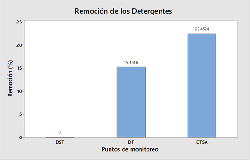Efectividad de un filtro en la eliminación de detergentes de aguas residuales urbanas de Cajamarca, Perú
DOI:
https://doi.org/10.51252/reacae.v2i2.511Palabras clave:
detergentes aniónicos, filtro, remediación ambiental, vertimientoResumen
La finalidad del presente estudio fue evaluar la efectividad del filtro de grava, sulfato de aluminio y carbón activado en la eliminación de detergentes de aguas residuales urbanas de la ciudad de Cajamarca. Métodos: Se realizó la caracterización del agua residual urbana y el monitoreo para los siguientes parámetros: detergentes (SAAM), pH y turbidez. La muestra fue obtenida de una lavadora industrial. Resultados: El filtro de grava, sulfato de aluminio y carbón activado, es efectivo para eliminar detergentes de aguas residuales urbanas de la ciudad de Cajamarca; dado que, se eliminó el 22,55% de los detergentes y el 98,51% de la turbidez. Conclusiones: Finalmente, se demostró la eliminación de los detergentes mediante el coagulante y un filtro de grava y carbón.
Descargas
Citas
Abdelmoez, W., Barakat, N. A. M., & Moaz, A. (2013). Treatment of wastewater contaminated with detergents and mineral oils using effective and scalable technology. Water Science and Technology, 68(5), 974–981. https://doi.org/10.2166/wst.2013.275
Azizullah, A., Khan, S., Rehman, S., Taimur, N., & Häder, D.-P. (2021). Detergents Pollution in Freshwater Ecosystems. In Anthropogenic Pollution of Aquatic Ecosystems (pp. 245–270). Springer International Publishing. https://doi.org/10.1007/978-3-030-75602-4_12
Barambu, N. U., Peter, D., Yusoff, M. H. M., Bilad, M. R., Shamsuddin, N., Marbelia, L., Nordin, N. A. H., & Jaafar, J. (2020). Detergent and Water Recovery from Laundry Wastewater Using Tilted Panel Membrane Filtration System. Membranes, 10(10), 260. https://doi.org/10.3390/membranes10100260
Chen, X., Wang, Y., Bai, Z., Ma, L., Strokal, M., Kroeze, C., Chen, X., Zhang, F., & Shi, X. (2022). Mitigating phosphorus pollution from detergents in the surface waters of China. Science of The Total Environment, 804, 150125. https://doi.org/10.1016/j.scitotenv.2021.150125
Cheng, W.-H. (2009). Using a biological aerated filter to treat mixed water-borne volatile organic compounds and assessing its emissions. Journal of Environmental Sciences, 21(11), 1497–1502. https://doi.org/10.1016/S1001-0742(08)62446-8
Goel, G., & Kaur, S. (2012). A Study on Chemical Contamination of Water Due to Household Laundry Detergents. Journal of Human Ecology, 38(1), 65–69. https://doi.org/10.1080/09709274.2012.11906475
Haderiah, H., Sulasmi, S., & Erlani, E. (2015). Effectiveness of Simple Screening Media of Activated Chorcoal and Zeolite to Reduce Waste Water Levels in Laundry Detergent. International Journal of Sciences: Basic and Applied Research (IJSBAR), 24(3), 180–186. https://gssrr.org/index.php/JournalOfBasicAndApplied/article/view/4676
Jahan, K. (2004). Detergents. In Water Encyclopedia (pp. 669–674). Wiley. https://doi.org/10.1002/047147844X.ww66
Liu, Y., & Chen, J. (2014). Phosphorus Cycle. In Encyclopedia of Ecology (pp. 181–191). Elsevier. https://doi.org/10.1016/B978-0-12-409548-9.09043-6
Mclntyre, A., & He, X. (2019). Global Marine Pollution—A Brief History. In Encyclopedia of Ocean Sciences (pp. 231–235). Elsevier. https://doi.org/10.1016/B978-0-12-409548-9.11429-0
Mensah, K. A., & Forster, C. F. (2003). An examination of the effects of detergents on anaerobic digestion. Bioresource Technology, 90(2), 133–138. https://doi.org/10.1016/S0960-8524(03)00126-3
Mousavi, S. A., & Khodadoost, F. (2019). Effects of detergents on natural ecosystems and wastewater treatment processes: a review. Environmental Science and Pollution Research, 26(26), 26439–26448. https://doi.org/10.1007/s11356-019-05802-x
Rojas-Herrera, R. A., Ramos-Castillo, A. S., Estrada-Medina, H., De los Santos-Briones, C., Keb-Llanes, M. A., Barrientos-Medina, R. C., Peña-Ramírez, Y. J., & O’Connor-Sánchez, A. (2015). Living with detergents: pyrosequencing-based assessment of bacterial community structures in soils subjected for decades to contamination by detergents. Annals of Microbiology, 65(3), 1313–1322. https://doi.org/10.1007/s13213-014-0969-x
Sharo, A. A., & Daradkah, B. H. (2020). Optimizing the Impact of Detergents Contamination on the Geotechnical Properties of Soils. Procedia Manufacturing, 44, 615–622. https://doi.org/10.1016/j.promfg.2020.02.248
Tsyntsarski, B., Petrova, B., Budinova, T., Petrov, N., Teodosiev, D. K., Sarbu, A., Sandu, T., Ferhat Yardim, M., & Sirkecioglu, A. (2014). Removal of detergents from water by adsorption on activated carbons obtained from various precursors. Desalination and Water Treatment, 52(16–18), 3445–3452. https://doi.org/10.1080/19443994.2013.801327
Yaseen, Z. M., Zigale, T. T., Tiyasha, D., R. K., Salih, S. Q., Awasthi, S., Tung, T. M., Al-Ansari, N., & Bhagat, S. K. (2019). Laundry wastewater treatment using a combination of sand filter, bio-char and teff straw media. Scientific Reports, 9(1), 18709. https://doi.org/10.1038/s41598-019-54888-3

Publicado
Cómo citar
Número
Sección
Licencia
Derechos de autor 2023 Persi Vera-Zelada , Luis Alberto Vera-Zelada, Elvis Humberto Saucedo-Osorio, Leily Bettsy Mamani-Arias

Esta obra está bajo una licencia internacional Creative Commons Atribución 4.0.
Los autores retienen sus derechos:
a. Los autores retienen sus derechos de marca y patente, y tambien sobre cualquier proceso o procedimiento descrito en el artículo.
b. Los autores retienen el derecho de compartir, copiar, distribuir, ejecutar y comunicar públicamente el articulo publicado en la Revista Amazónica de Ciencias Ambientales y Ecológicas (REACAE) (por ejemplo, colocarlo en un repositorio institucional o publicarlo en un libro), con un reconocimiento de su publicación inicial en la REACAE.
c. Los autores retienen el derecho a hacer una posterior publicación de su trabajo, de utilizar el artículo o cualquier parte de aquel (por ejemplo: una compilación de sus trabajos, notas para conferencias, tesis, o para un libro), siempre que indiquen la fuente de publicación (autores del trabajo, revista, volumen, número y fecha).



